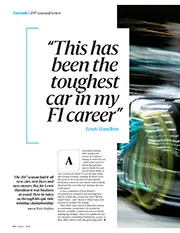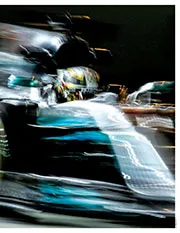

“This has been the toughest car in my F1 career”
The 2017 season had it all – new cars, new faces and new owners. But for Lewis Hamilton it was business as usual. Here he takes us through his epic…
Twenty-five years ago, Richard Attwood let me drive his Porsche 917. At the time it was the greatest automotive experience of my life and in the quarter century of unfathomable good luck that has since passed under my wheels, only a handful of other experiences get anywhere near it. And it was not just because I had a 917 and Silverstone to myself. What I remember as much as the fear, the excitement, the sight, sound and feel of the car was Richard’s attitude. Every time I came in he’d ask me how it was. I’d tell him and he’d say, “Yes, yes, but have you had a proper go yet?” Truth is that out of respect for the car, its value, its reputation and its owner, I was driving it fast, but not hard. “Don’t worry about it,” he said with good-natured testiness, “you’ll be fine. Just get out there and really drive the thing.” So I did. I can say in all sincerity that I’ve driven a Porsche 917 as fast as I can make it go. Which even after all these years is still quite something to consider. At least to me.
Because so often you get in some amazing car and the owner, quite understandably, wishes to ensure it comes back in the same condition. So limits on revs, or laps or style of driving (“no drifting!”) are at times applied and they are always rigidly adhered to. I’m sure I’ve only been track testing cars for this long because I’m perceived to be a tolerably safe pair of hands, so far at least.
But just occasionally you get another Attwood, someone whose only agenda is that you do not step out their car until you have experienced it at the very limit of its ability. Such a person is Clive Beecham whose ex-Stirling Moss, TT-winning Ferrari 250 SWB adorns the cover of this magazine. “You’ll have to use all 7700rpm to get the most out of it,” – which I did, and, “Expect you’ll be drifting it on the first lap” are examples of his extraordinary trust and generosity. Which is the only reason I really did get to fling the SWB around Goodwood and now have memories that will last as long as any gathered in all the years I’ve been doing this job.
A few weeks ago I drove over to Max Girardo’s place in the heart of the Oxfordshire countryside for various reasons including taking a look at his newly constructed showroom and drool over its contents. But when there’s a Ferrari 512 S front and centre everything else seems to fade into the background. I have a list in my head of cars I’d happily lose a limb to drive and Maranello’s hastily devised response to the aforementioned 917 is right up there, vying for position with a McLaren M8F and a Mercedes-Benz W125.
This is chassis 1004, raced by Jacky Ickx at Daytona in 1970 where it failed to finish and John Surtees at Monza where it finished third before becoming the test bed for the Coda Lunga long tail bodywork desperately required to keep up with the Porsches at Le Mans. For this strings were pulled, a section of autostrada was closed along which Arturo Merzario and Peter Schetty went barrelling reporting an increasingly uncomfortable ride quality above 215mph. It then found its way to Steve McQueen’s Solar Productions where it was driven for his 1971 Le Mans film and its body panels used to clothe a radio-controlled Lola T70 in its most famous crash sequence.
Anyway, I sat in it and my unhelmeted head stuck so far proud of the bodywork we couldn’t even close the door. So my hopes of now driving a 512 S rest with those left in spider configuration. Fancy my chances? Me neither.
Once I’d done what I’d gone there to do, I had coffee with Max and found ourselves discussing a question to which neither of us had an answer. I still don’t. Why is it you can drive two old cars, both equally revered in period, and one may be even more wonderful than you remember while the other leaves you rather wishing you’d never bothered climbing aboard? I have no idea.
“I find the Peugeot 205 GTI more charming now than 40 years ago”
But the examples I chose to illustrate the point were the Peugeot 205 GTI which I find possibly even more charming today than I did nearly 40 years ago, and the mid-engined Renault 5 Turbo 2, which I did not. My brother briefly owned one of these in period and I was absolutely in awe of it, but when I drove another a few years ago I couldn’t understand what anyone had ever seen in it. It was slow, made an unpleasant noise and felt like it would enjoy nothing more than depositing you in a hedge at the earliest available opportunity.
What we did agree is that cars that were bad when new remain so for the rest of their lives. A car is not ‘classic’ just because it is old. Time can do many amazing things but making a poor car good is not among them.
I am detecting a slight increase in interest in hydrogen power as the limitations of electric cars and our already creaking charging network become more apparent by the day. I’ve said it before but it bears repeating that eventually hydrogen will have to be adopted because it is the only truly sustainable energy solution for mass transportation by road. And now I read a Skipton-based company called Element 2 plans to open 30 hydrogen stations in the UK before the end of the year, at least doubling the current number, and aimed primarily and for now at the haulage industry. It’s not much, but it’s a start.
A former editor of Motor Sport, Andrew splits his time between testing the latest road cars and racing (mostly) historic machinery
Follow Andrew on Twitter @Andrew_Frankel